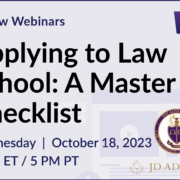Three LSAT Logical Reasoning Tips To Boost Your Score
Three LSAT Logical Reasoning Tips To Boost Your Score
The LSAT Logical Reasoning portions of the exam are worth more than half of your overall score (51/101 points). Suffice to say, you need to do well on these sections in order to score well on the LSAT. If you are struggling, we’re here to help! Check out these LSAT Logical Reasoning tips to evaluate your approach and performance!
Three LSAT Logical Reasoning Tips To Boost Your Score
1. Always practice under timed conditions!
It is impossible to overstate how important it is to prepare for the timing aspect of the LSAT. While this is true for every section, it is especially true for the LSAT Logical Reasoning sections. Although the Reading Comprehension passages are longer, they are, in a sense, easier to get through. You’ll only be asked to read and evaluate four selections, and then answer questions about them. In the Logical Reasoning section, however, you need to work through 51, albeit much shorter, passages. Although this might not seem like that much when you read the questions, it actually is a ton of text to get through. And with the constantly changing subjects, it is difficult to keep everything straight.
Since timing is such a crucial element in the LSAT Logical Reasoning sections, you need to master it early on in your prep. You should always time yourself of this section. The only way to internalize an alarm clock is to practice. If you are not taking a whole section, prorate your time down. Whatever you do, make sure that you are well-versed in staying under 35 minutes per section.
2. Analyze your incorrect answers, and see if a pattern emerges.
If you think you’re done with LSAT review after taking practice questions and scoring them, you are doing it wrong! It is equally important to look over your incorrect answers and evaluate your performance. This is the best way to identify your weaknesses in the LSAT Logical Reasoning section. It may be you may struggle with a particular question type. You won’t know that, however, if you don’t analyze your incorrect answers.
After you complete a section and score it, go back and categorize each question. Depending on your prep course and material, there are somewhere between 10-15 different types of question. Whatever labels and language you use to identify them really don’t matter, as long as you are consistent. Then, see if a pattern emerges. If you are consistently getting a specific type of question wrong, focus your review on it next time. This way, you’ll know what you need help with, and can more easily address any shortcomings in your prep.
3. Don’t be afraid to skip around!
After you’ve analyzed your performance, let the patterns you find inform your approach moving forward. Ideally, you want to be equally as comfortable dealing with, say, inference questions as you are with parallel reasoning questions. However, this isn’t always the case! Most people have a particular question type that gives them trouble. Our advice when you practice, and on test day, is to try to minimize those weaknesses by skipping around in the LSAT Logical Reasoning sections.
Now, this may seem counterintuitive, since you ultimately need to answer every question on the test. However, consider the following. Of all the sections on the test, the LSAT Logical Reasoning section gives you the most leeway to skip questions you struggle with. In the Reading Comprehension and Logical Games portions, this is much more difficult. In both these sections, skipping individual questions doesn’t work well because they are tied either to a larger reading passage or game. Skipping in and out of scenarios in these sections is inefficient because every time you go back, you have to refamiliarize yourself with the scenario. In the LSAT Logical Reasoning sections, however, each passage is contained in one question, so there’s no overall theme or structure to worry about.
So, if you know you struggle with a particular question type, skip it and come back later! You want to see all the questions in each section. It might be that you struggle with question 15 but don’t have any problems answering questions 21 through 25. However, if you spend 5 minutes trying to answer question 15, you’ll never see the others! Prioritize the questions you know how to answer immediately by reading the question below the passage. Then, come back to any questions you struggle with at the end.
Pursuing Law School? We’ve Got You Covered!
🌟 Special Offer: Enroll in our FREE on-demand law school prep course, meticulously crafted by a top-ranked law student. Secure your spot now






Leave a Reply
Want to join the discussion?Feel free to contribute!